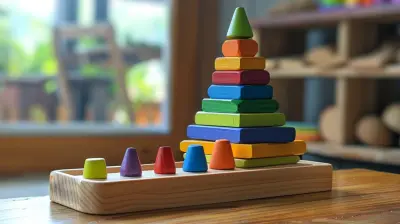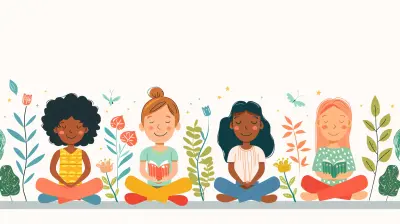12 October 2025
Ever feel like your brain is a cluttered attic, stuffed with random facts, ideas, and to-do lists that make no sense when you actually need them? You're not alone. Our minds are incredible, but they can be chaotic. That's where mind mapping comes in—a simple yet powerful tool that helps you organize your thoughts, boost creativity, and make learning way easier.
But wait… What exactly is mind mapping? And how can it revolutionize the way you learn? Buckle up, because we’re diving deep into the magic of mind maps! 
What is Mind Mapping?
Imagine taking all the messy thoughts in your head and arranging them on paper in a way that actually makes sense. Instead of writing in boring, linear notes, a mind map lets you visualize ideas in a structured, colorful, and creative way.At its core, a mind map is a diagram that connects ideas around a central topic. Think of it like a spider web, where one big idea sits in the center, and smaller, related ideas branch off like tiny legs. With images, colors, and keywords, it transforms the way you process and retain information. 
Why Does Mind Mapping Work So Well?
The reason mind mapping is so effective is simple: it mimics the way your brain naturally works. Our brains don’t think in long paragraphs or straight lines—they jump between ideas, make connections, and form patterns. Mind maps tap into that natural process, making it easier to absorb and recall information.Plus, they engage both hemispheres of the brain. While the left side loves logic and structure, the right side thrives on creativity and visuals. Mind mapping brings both together, making learning a whole-brain experience. 
Benefits of Mind Mapping for Learning
So, why should you ditch traditional note-taking and start using mind maps? Here are some game-changing benefits:1. Boosts Memory and Retention
Studies show that visuals help memory better than plain text. By associating ideas with images and colors in a mind map, your brain retains information much faster—almost like sticking mental Post-it notes directly onto your memory.2. Enhances Creativity
Mind mapping isn't just about organization; it's a creativity booster. The open-ended nature of mind maps encourages free thinking, helping you generate new ideas, solve problems, and approach topics from different angles.3. Simplifies Complex Topics
Ever tried to summarize an entire textbook in notes—only to end up drowning in endless pages? Mind maps help break down dense topics into easy-to-digest chunks, making learning less overwhelming and more manageable.4. Improves Focus and Engagement
Traditional note-taking can quickly become a snooze-fest (we’ve all been there). Mind maps, on the other hand, keep you actively engaged with colors, keywords, and diagrams that make studying exciting instead of dull.5. Encourages Better Organization
If your notes often resemble a chaotic scribble-fest, mind mapping helps bring structure and clarity to your thoughts. Everything is visually linked, so you can easily recall and connect information.
How to Create a Mind Map in 5 Simple Steps
Ready to give it a try? Creating a mind map is surprisingly easy, and you don’t need fancy tools—just paper, pens, and your imagination.Step 1: Start with a Central Idea
Write your main topic in the center of the page. This could be a subject you're studying, an essay topic, or even just a problem you need to solve. Draw a circle or a fun shape around it to make it stand out.Step 2: Add Main Branches
Think of 4-6 key concepts related to your topic. These form the main branches connecting to the central idea. Use bold colors to differentiate them and make them visually distinct.Step 3: Expand with Subtopics
Each main branch can have smaller branches that break down information further. Add keywords, short phrases, or even doodles to make them memorable.Step 4: Use Colors and Images
The more visual your mind map, the better. Use different colors for different branches, draw icons, and add symbols that help you associate information with specific ideas.Step 5: Keep It Simple and Flexible
Mind maps are all about flexibility. There’s no wrong way to do it! If new ideas pop up, simply add another branch. It’s a free-flowing process designed to grow as your understanding deepens.Best Ways to Use Mind Mapping for Learning
Mind mapping isn't just for students—it's a tool that works for anyone looking to organize their thoughts. Here are some powerful ways to use it:1. Note-Taking for Classes
Instead of writing long-winded notes, use a mind map to summarize key points from a lecture or textbook. It’ll help you visualize connections between concepts faster.2. Brainstorming for Essays and Projects
Before staring at a blank document in panic mode, sketch out a mind map to gather and organize ideas logically. This saves time and prevents writer’s block.3. Studying for Exams
Condense an entire subject into a single mind map. It serves as a quick-reference cheat sheet, helping you recall important details easily before the test.4. Learning a New Language
Mind maps are fantastic for language learners! Create branches for grammar, vocabulary, and phrases, making it easier to see connections and remember words.5. Managing Daily Life and Productivity
Beyond academics, mind maps can help you organize tasks, set goals, or even plan events. It’s your personal roadmap to staying on top of things without feeling overwhelmed.Digital vs. Handwritten Mind Maps: Which One is Better?
Stuck between using pen and paper or a mind mapping app? Let’s weigh the pros and cons:Handwritten Mind Maps
✔ Boosts creativity and memory retention✔ Gives full control over layout and design
✔ No distractions from screens
✘ Can get messy
✘ Harder to edit and rearrange
Digital Mind Maps
✔ Easily editable and expandable✔ Can include links, images, and videos
✔ Perfect for sharing notes with others
✘ Less engaging than handwriting
✘ Can lead to distractions from other apps
The best approach? Mix both! Draw quick sketches by hand and later digitize them using apps like XMind, MindMeister, or SimpleMind.
The Science Behind Mind Mapping
Okay, so you might be wondering—does mind mapping really work, or is it just another hype? Science backs it up!A study published in Thinking Skills and Creativity found that students who used mind maps retained 10-15% more information compared to traditional note-taking. Another study from the University of London revealed that mind mapping enhances problem-solving and critical thinking skills—both essential for learning and academic success.
In short? Mind mapping isn’t just a cool trick—it’s a scientifically proven learning hack that helps your brain absorb and recall knowledge more effectively.
Final Thoughts
Mind mapping is a total game-changer for learning, problem-solving, and creativity. Whether you're a student, a professional, or just someone who loves organizing thoughts visually, this tool can revolutionize the way you think.So, the next time your brain feels like a jumbled mess, grab a sheet of paper (or open a mind mapping app) and start connecting the dots. You’ll be amazed at how much clearer and structured your thoughts become!
Now, are you ready to give mind mapping a try? Get started today and unleash the full potential of your brain!








Zariah Marks
Mind mapping is a transformative tool that enhances understanding by visually organizing thoughts. It bridges connections and stimulates creativity, making complex information more digestible. Embracing this technique can unlock deeper insights and foster a more engaging learning experience.
November 5, 2025 at 9:21 PM